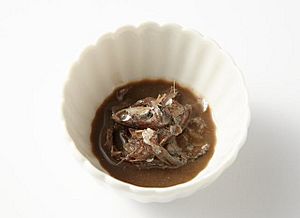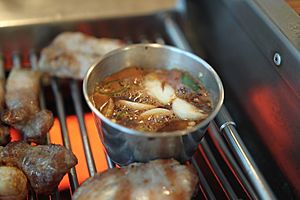Myeolchi-jeot facts for kids
 |
|
| Alternative names | Meljeot, salted anchovies |
|---|---|
| Type | Jeotgal |
| Place of origin | Korea |
| Main ingredients | Anchovies |
| Korean name | |
| Hangul |
멸치젓
|
|---|---|
| Revised Romanization | myeolchi-jeot |
| McCune–Reischauer | myŏlch'i-chŏt |
| IPA | [mjʌl.tɕʰi.dʑʌt̚] |
Myeolchi-jeot (멸치젓) is a popular Korean food. It is also known as salted anchovies. This dish is a type of jeotgal, which means salted seafood. It is made by salting and fermenting small fish called anchovies.
Myeolchi-jeot is one of the most common salted seafoods in Korean cuisine. Another popular one is saeu-jeot, which is made from salted shrimps. In mainland Korea, myeolchi-jeot is mostly used to make kimchi. On Jeju Island, meljeot (멜젓) is also used as a dipping sauce. The Chuja Islands, located between South Jeolla and Jeju, are famous for making the best myeolchi-jeot.
What's in a Name?
The name Myeolchi-jeot (멸치젓) comes from two Korean words. Myeolchi (멸치) is the Korean word for anchovy. Jeot (젓) means salted fermented seafood.
On Jeju Island, this dish is called Meljeot (멜젓). Here, mel (멜) is the Jeju name for anchovy. The word mel is similar to the first part of myeolchi. Other similar names like metjeot (멧젓) and mitjeot (밋젓) are used in other parts of Korea.
How It's Made
Anchovies for Myeolchi-jeot are caught in large numbers. They are found along the southern coasts of the Korean Peninsula. For making gimjang (a big kimchi-making event), mature anchovies are used. These are caught in July and August.
On Jeju Island, larger anchovies caught in spring are used for meljeot. These are found along the coasts of Seogwipo.
First, fresh anchovies are cleaned and drained in bamboo baskets called sokuri. Then, they are salted with coarse salt. The salt should weigh about 15-20% of the anchovies' weight. The anchovies and salt are placed in layers inside an onggi (earthenware jar). A thick layer of salt is put on top. This stops the anchovies from touching the air.
The jar is sealed, and the salted anchovies ferment for two to three months. They are kept at a temperature of 15-20 degrees Celsius. After a few more months, the myeolchi-jeot turns into myeolchi-jeot-guk. This is a liquid anchovy extract.
How to Use It

The liquid extract from myeolchi-jeot is ready after about six months of fermenting. This liquid is filtered and boiled. It is then used to add flavor when making kimchi. You can also mix two parts myeolchi-jeot with one part water. Boil it, filter it, and let it settle. The clear liquid on top is then used in kimchi.
This boiled and filtered anchovy liquid can also flavor seaweed dishes. If myeolchi-jeot is made with anchovies that have had their bones removed, it can be seasoned. Then it is eaten as banchan, which means a side dish.
On Geomun Island, it's hard to grow soybeans. So, the leftover solids and cloudy liquid from myeolchi-jeot are used. They make a special anchovy paste called myeoljang.
In Jeju Island, meljeot is a popular dipping sauce for grilled pork. In summer, people use meljeot with blanched soybean leaf ssam (a wrap). In winter, napa cabbage leaves are dipped in meljeot. Meljeot can also be eaten as a banchan by itself. Sometimes it's seasoned with garlic and chili peppers.
Gallery
-
Myeolchi-aekjeot
See also
 In Spanish: Myeolchijeot para niños
In Spanish: Myeolchijeot para niños


